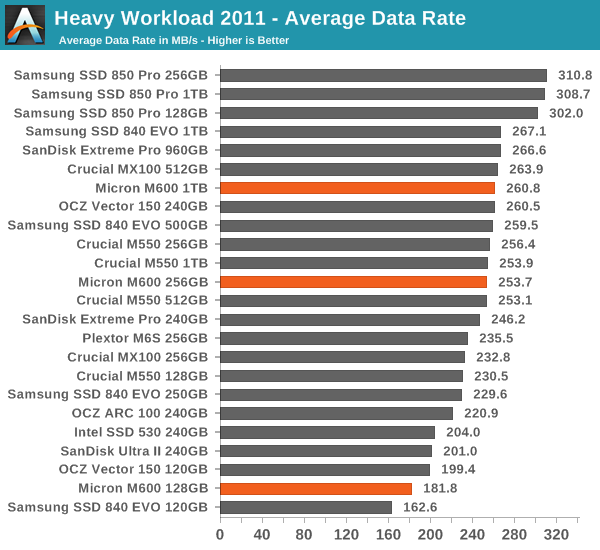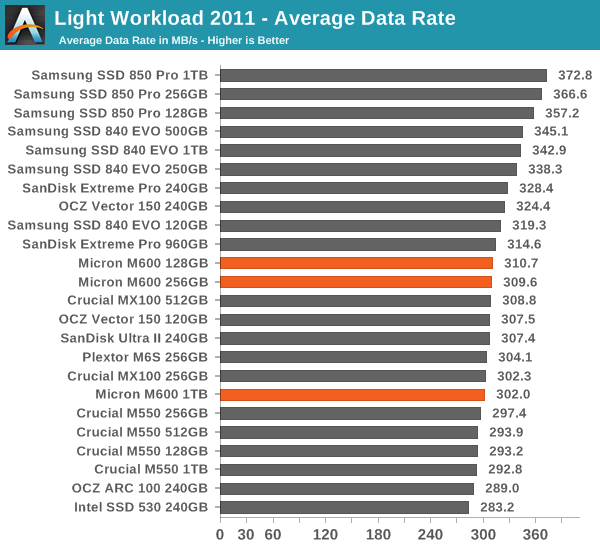Micron M600 (128GB, 256GB & 1TB) SSD Review
by Kristian Vättö on September 29, 2014 8:00 AM ESTAnandTech Storage Bench 2011
Back in 2011 (which seems like so long ago now!), we introduced our AnandTech Storage Bench, a suite of benchmarks that took traces of real OS/application usage and played them back in a repeatable manner. The MOASB, officially called AnandTech Storage Bench 2011 – Heavy Workload, mainly focuses on peak IO performance and basic garbage collection routines. There is a lot of downloading and application installing that happens during the course of this test. Our thinking was that it's during application installs, file copies, downloading and multitasking with all of this that you can really notice performance differences between drives. The full description of the Heavy test can be found here, while the Light workload details are here.

Dynamic Write Acceleration starts to show its strength in our 2011 Benches. Since the Heavy and Light suites are run on an empty drive, the M600 can take full advantage of its dynamic SLC cache and as a result the M600 is faster than the MX100, although not substantially so. It seems that Samsung's TurboWrite is better optimized for light client workloads, though, as in our Light suite the EVO is faster even at the smallest capacities. That said, the difference is quite negligible, but it is interesting nevertheless.











56 Comments
View All Comments
milli - Monday, September 29, 2014 - link
The MX100 already had terrible service time. The M600 is even worse.I mean if it's even worse than this showing the MX100 delivered (http://techreport.com/r.x/adata-sp610/db2-100-writ... then forget about it.
milli - Monday, September 29, 2014 - link
http://techreport.com/r.x/adata-sp610/db2-100-writ...Link got messed.
BedfordTim - Monday, September 29, 2014 - link
If service times are such an issue why did Tech Report give the MX100 an Editor's Choice award?milli - Monday, September 29, 2014 - link
Because everybody is a sucker for low prices.menting - Monday, September 29, 2014 - link
i guess you go out and buy the fastest, regardless of price then?milli - Monday, September 29, 2014 - link
Obviously not. I'm just giving one of the main reasons why the MX100 wins so many awards.Samus - Monday, September 29, 2014 - link
It's still a better drive than competing products in its price segment. The only other drive that comes close is the 840 Evo (which apparently has some huge performance bugs on static data - and support is terrible...the bug has existed for over a year.)You could consider spending more money on an Intel drive or something from Sandisk, but most consumers need something "reliable-enough" and price is always the driving factor in consumer purchases. If that weren't true, you wouldn't see so many Chevy Cobalt's and Acer PC's.
The irony is, for price and reliability, the best route is a used Intel SSD320 (or even an X25-M) off eBay for $60 bucks. They never fail and have a 15 year lifespan under typical consumer workloads. They're still SATA 3Gbps, but many people won't notice the difference if coming from a hard disk. Considering the write performance of many cheap SSD's anyway (such as the M500) the performance of a 4 year old Intel SSD might even still be superior.
Cellar Door - Monday, September 29, 2014 - link
My X-25M failed after 2 years of use. So please don't use the word 'never' - Intel sent me a 320 as a replacement, due to 3 year warranty. Performance wise, it's ancient but still an ssd.Samus - Monday, September 29, 2014 - link
Like many SSD's, they are prone to failure from overfapping.Lerianis - Friday, October 3, 2014 - link
Eh? Overwriting, I think you mean. That said, all of these drives should be able to handle 20GB's write per day at least for years without issues.